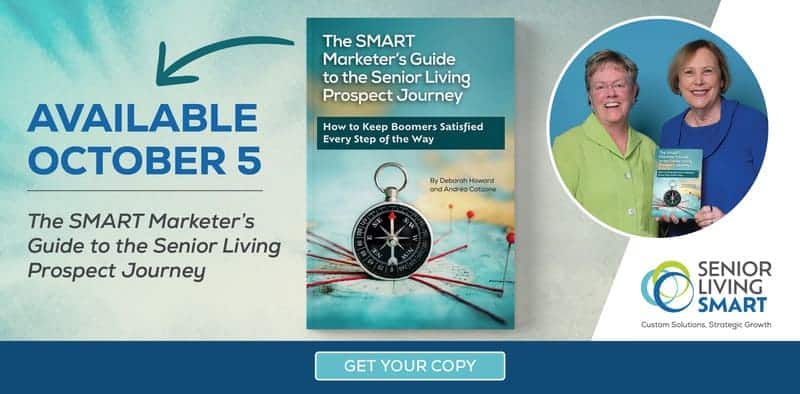How to Create a Great Brand Experience for Residents
It’s easy to think the senior living marketing team’s job ends once a prospect becomes a resident. But consider this sobering stat: According to the Massachusetts Executive Office of Elder Affairs’ 2023 Annual Aggregated Data Report for Assisted Living Residencies, 17% of residents who moved out did so within just ninety days of moving in.
And while that data reflects one state, we’ve heard similar stories from clients across the country.
Early move-outs are more than just frustrating—they’re disruptive to occupancy, revenue, and reputation. Preventing them starts with one essential strategy: delivering an exceptional brand experience that turns residents into raving fans.
Why create a great brand experience?
When you create a standout brand experience, you lay the groundwork for long-term satisfaction, glowing reviews, and referral-rich word of mouth.
Just ask Megan Longley, VP of Sales at ACTS Retirement-Life Communities, who shared during a recent panel that 50% of ACTS’ move-ins come from resident and family referrals.
Their secret? An intentional approach that focuses on consistently surprising and delighting new residents, and a formal referral program that taps into the enthusiasm of those happy residents and families.
At Senior Living SMART, we call this the “delight” stage—the critical window of time when you go beyond simply welcoming new residents and instead create a warm, memorable experience that builds lasting loyalty.
How to create a brand experience that delights residents and their families
Creating an exceptional brand experience begins before the new resident moves in. It requires careful planning, empathy, and a well-executed strategy.
Every transition point—from the initial deposit to the first month in the community—presents an opportunity to build trust and a sense of belonging.
Upon deposit, set the stage for a smooth transition.
The moment a resident makes a financial commitment is a pivotal point in their journey. It should feel seamless, not stressful.
- Make it easy to pay. Many people don’t carry checkbooks anymore, so don’t force prospects to leave and return with a check, which only gives them time to reconsider. To eliminate unnecessary roadblocks, offer digital payment options.
- Digitize paperwork. No one wants to take home a stack of forms to fill out manually. A digital process makes it easier for multiple family members to collaborate and stay organized.
- Coordinate logistics. As soon as the prospect makes the deposit, families start thinking about all the work ahead, like downsizing, selling a home, and finding movers. Reduce stress by providing resources and partnerships. Consider working with a professional relocation service to guide families through the process. (We recommend LivNow.)
PRO TIP: If your senior living community offers relocation services, do the following:
- Create a dedicated landing page on your site about the relocation services. Ideally, make it available and visible in the top-level navigation. Discuss how this service can benefit your future residents. Share testimonials from residents who’ve used the services. If the service doesn’t cost the resident anything, be sure to highlight this point.
- Promote the services in all pre-tour communications. For example, when someone schedules a tour online, the thank-you page and the auto-responder email should highlight this service and explain how people can contact a counselor for a free consultation.
- Highlight the service in all post-tour communications. Remind people about this service and make it easy for someone to contact a relocation counselor.
- Make virtual intros. If the salesperson senses a once-hot lead is getting cold feet, they should take the initiative and make a virtual introduction between the prospect and a relocation counselor.
- Promote the service throughout the community’s website, social media platforms, and marketing events. Again, if moving is one of the biggest barriers to entry, break down this barrier.
Formally transfer the relationship from sales to operations.
The salesperson has spent weeks, sometimes months, building rapport and trust and knows the future resident’s hopes, interests, and life story. If this information isn’t transferred to the rest of the community’s key team members, that personal connection is lost, and the transition can feel cold and impersonal.
- Create a new resident profile. Pull notes from the CRM and supplement with a resident life history survey. Mining social media for additional personal insights can help staff make meaningful connections early on.
- Host a transition meeting. Gather department heads and team leaders to share details about the new resident, ensuring everyone is prepared to create a warm welcome.
- Develop a personalized transition plan. Identify residents with similar interests or backgrounds who can serve as buddies. Schedule introductory activities that align with the new resident’s hobbies. Maintain their daily routines as much as possible.
- Introduce staff in advance. Provide families with a directory of key team members, including photos and contact information. Some communities even create playing cards with employee faces, names, and fun facts to make introductions easier.
Plan a memorable move-in day.
Move-in day can be overwhelming. Whether a planned transition or a sudden move, the experience should be well-coordinated to minimize stress.
- Personalize the welcome. Engage the resident welcome committee to prepare for the new arrival. Share relevant background information so they can create a thoughtful orientation plan. A personal note from a current resident can go a long way in making a newcomer feel expected and valued.
- Create move-in day checklists. Give each department in your senior living community an internal checklist to make sure they are ready for the new resident. For example, the apartment readiness checklist, dining/meal plan checklist, activities checklist, etc.
- Develop move-in day protocols. Examples include leaving a welcome basket on the kitchen counter, providing a welcome packet in people’s apartments with helpful info, issuing a resident handbook, or assigning a resident from the welcome committee to be the new resident’s go-to person during the first few weeks.
- Make the arrival special. Some communities roll out the red carpet, while others place a ribbon across the apartment door for the resident to cut. Personalized wreaths and welcome signs on the door create an instant sense of belonging.
- Assign a staff member to assist the family. Designate a team member to stay with the resident and their family throughout the move-in process—helping them settle in, answering questions, and providing escorts to meals or activities.
- Offer hospitality. A stocked fridge, snacks, and a goody basket with necessities (paper goods, hand soap, etc.) can make the transition smoother. Encourage the family to stay for a meal in the dining room to start integrating into the community.
Foster connection and engagement during the first week.
The first week is all about relationships. Residents need to feel comfortable with both staff and fellow residents.
- Schedule personal meet-and-greets. Staff should take time to introduce themselves personally and explain their roles. Create an internal orientation checklist so each department knows what to cover.
- Empower the resident welcome committee. Assign experienced residents to check in with newcomers, invite them to meals, and help them navigate community life.
- Overcommunicate with families. Send updates and photos showing them engaging with staff and fellow residents. Address concerns immediately to avoid minor issues snowballing into bigger problems.
Focus on creating a sense of belonging during the first month.
The first month sets the tone for a resident’s long-term satisfaction. Boomers, in particular, aren’t looking for a passive retirement. They want to stay socially, physically, and mentally engaged, which means communities must go beyond bingo and crafts to offer experiences that align with their interests.
- Automate surprises and special treats. Schedule weekly surprises like gift certificates for the salon, dining passes for family visits, or a small bouquet of flowers on day thirty to celebrate their first month.
- Create opportunities for social integration. Set up a community dining table where new residents can meet others in a structured setting. Develop a digital directory or app where residents can find others with similar interests, browse the activity calendar, and submit service requests.
- Monitor progress. Use daily stand-up meetings to track how new residents are adjusting. Are they attending activities? Are they making connections? Is their family expressing concerns? Small course corrections can prevent larger issues down the road.
Great brand experiences don’t just happen.
Creating a positive brand experience for new residents isn’t just about making a good first impression. It’s about laying the foundation for long-term satisfaction, referrals, and retention. Need help developing a brand experience that turns your residents into raving fans? Get in touch, and let us help.














